How to Promote Affiliate Links: The Basics and Best Practices

Are you an affiliate marketer who wants to learn how to promote affiliate links? Or do you have an affiliate marketing program but want to help your affiliates market your products? If so, you’re in luck! In this post, we’ll share a few tips that will help you get started. Keep in mind that the key to success is experimentation – so be sure to try out different strategies and see what works best for you. With that said, let’s get started!
Table of Contents
Help Your Affiliates Promote Your Products Today
Start your affiliate program in minutes with GrowthHero, the all-in-one affiliate app, and grow your business to new heights.
What are affiliate links?
Affiliate links are unique, trackable URLs containing an affiliate’s ID or username. Affiliates marketing programs use affiliate links to record any traffic sent to the website through the affiliate. When users click the affiliate link and perform a specific action, the affiliate receives a commission. Affiliates can receive a commission based on:
- Cost per Lead (CPL)
- Cost per Action (CPA)
- Cost per Click (CPC)
- Cost per Sale (CPS)
- And more
In a traditional Cost per Sale (CPS) model, the affiliate marketing links work like this:
- Your affiliate program provides an affiliate link to the affiliate.
- Next, the affiliate promotes the link on a social channel.
- A user clicks on the affiliate link.
- The link sends the customer to a specific page on your affiliate website. In addition, the links track the customer through a cookie.
- The customer purchases a product.
- Your affiliate program attributes the sale to the affiliate.
- You issue a commission to the affiliate.
- Then, the affiliate receives a commission.
It may look like coded nonsense if you’re not familiar with affiliate links, but an affiliate link has many essential parts to help your program track your affiliates efficiently.
The Parts of an Affiliate Links
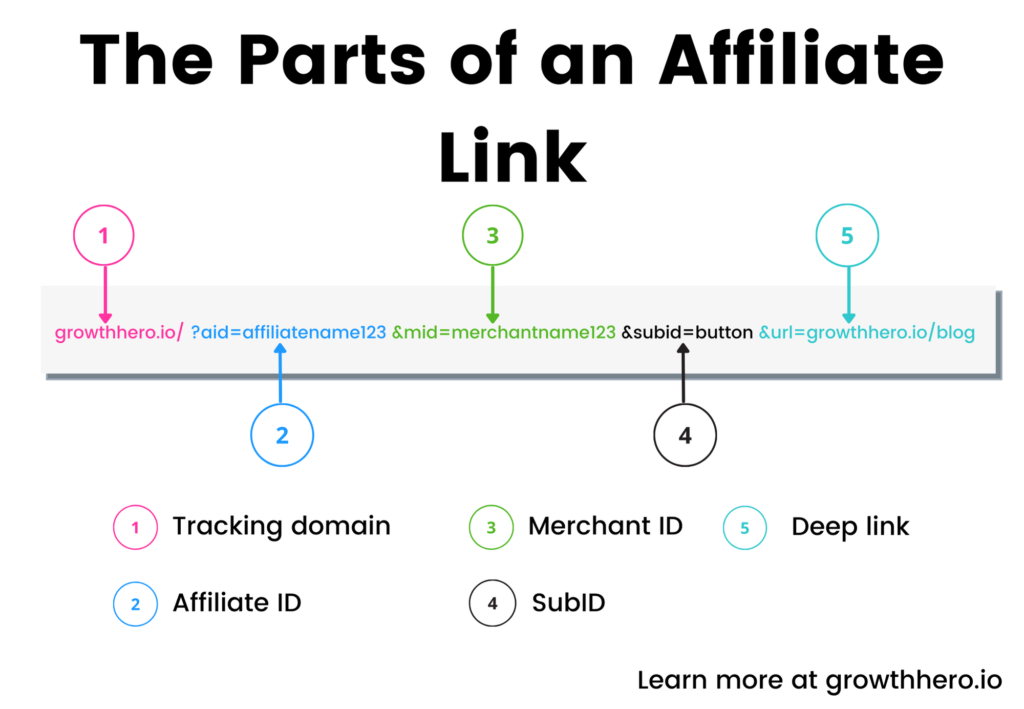
-
- Affiliate tracking domain: The affiliate program’s domain forwards a lead to your website.
- Affiliate ID: This identifies the affiliate.
- Merchant ID: This identifies the merchant who receives the referral.
- SubID: Customizable text to track which content and link types drive the most conversions.
- Deeplink: Where website visitors are sent when they link the affiliate link, typically a product page or landing page.
Most affiliate links follow this formula, combining elements to make a unique link to track your affiliates across their social media channels.
What are first-party affiliate cookies, and how are they different from affiliate links?
Cookies are files containing small snippets of data. Third-party cookies are cookies your company uses to track visitor behavior across various marketing channels.
Affiliate programs use first-party cookies with their affiliate links. When you provide your affiliates a unique link, affiliate marketers promote the URL, and the cookie attached to the link traces their conversions back to them. This helps your company track all affiliate activity through links and contributes to fair affiliate compensation.
Certain browsers like Chrome, Firefox, and Safari decided to eliminate third-party cookies, but as affiliate marketers use first-party cookies, they aren’t affected by this cookie ban.
How to Use Affiliate Links
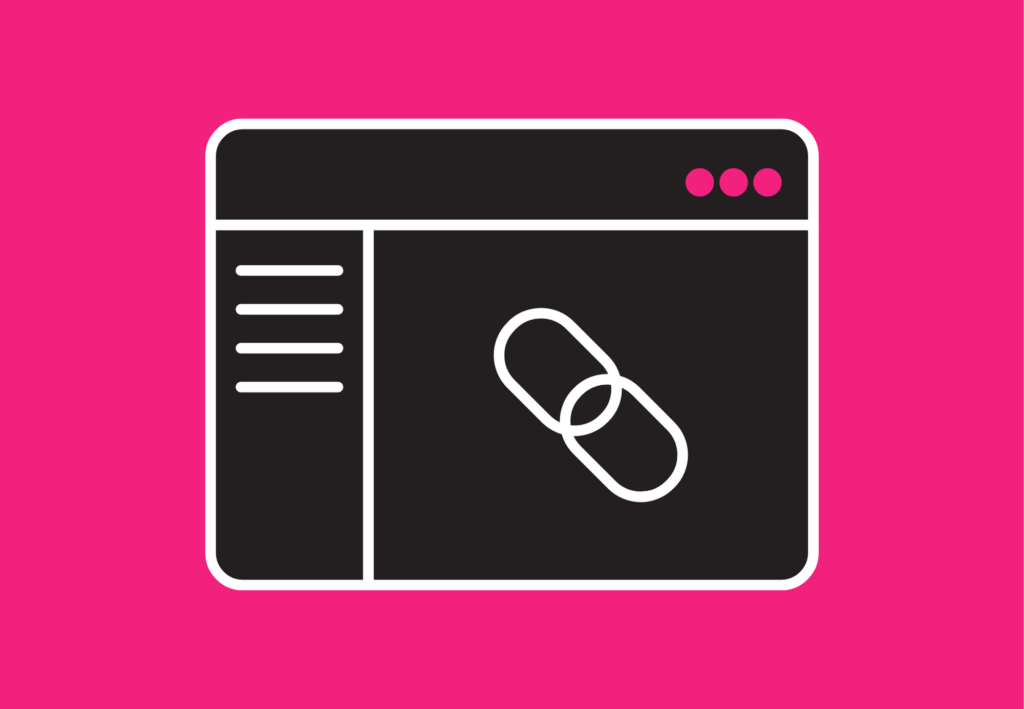
When your affiliates create content for their audience, they must consider a few factors:
- How other affiliates are marketing the product
- How the product price compares to similar products in the industry
- How well the product fits with the audience.
- The market demand for the product
Creating valuable content is trying different things to see what sticks. It’s a cyclical process of trial and error. Quality content requires a significant time investment and is a longer-term strategy for most businesses. However, if your affiliates already have a following, chances are they’ve been producing quality content for a while and that their audience trusts them.
If you’re worried about the quality of content your affiliates put out, GrowthHero allows you to create your own content for them to market.
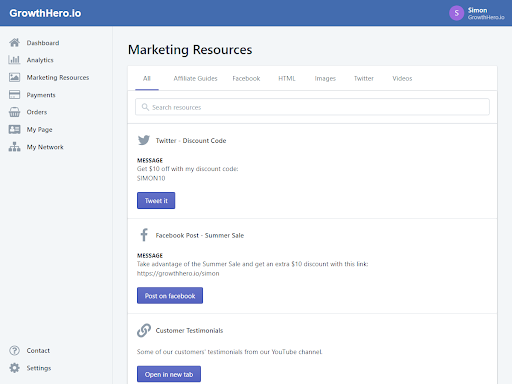
Customize tweets, Facebook posts, and more with our Marketing Resources section. This way, you have control over what affiliates say about your brand (which should also be specified in your terms and conditions).
Help Your Affiliates Promote Your Products Today
Start your affiliate program in minutes with GrowthHero, the all-in-one affiliate app, and grow your business to new heights.
How to Promote Affiliate Links

This section is geared towards your affiliates in your program. If you have affiliates struggling to market your products or if you’d like to teach your affiliates new methods to market your products, this is the article for them.
There are various ways to promote affiliate links, and the method you choose will depend on your goals, the products you’re promoting, and your target audience. In general, there are three main approaches: creating valuable content that includes affiliate links, using paid advertising to drive traffic to your affiliate links, and using social media to generate leads and sales.
Promoting your links is key to earning commissions. But with so many different ways to promote your links, it can be tough to know where to start. So, here are some of our favorite methods for promoting affiliate links along with examples of how to use them with GrowthHero.
- Use banners on your website
- Use affiliate links in newsletters
- Embed links in video descriptions
- Use links in product reviews and tutorials
- Insert links in your blog posts
- Promote links on social media and forums
Use banners on your website
Although affiliate discount codes and links are the traditional methods to drive sales, banners are also effective as they are visually appealing.
How our GrowthHero affiliates use this:

You can find RedFox Outdoor Equipment in our affiliate marketplace. RedFox uses GrowthHero to organize its affiliate marketing program. This is an example of a banner their affiliates can use. As you can see, an affiliate can fit this banner on their website, either in the header, footer or within the content. An affiliate would need to verify that the banner is linked to the affiliate program’s product landing page.
As a banner best practice, it’s best to place the banner higher on the page for better visibility. The higher on the page, the more clicks.
Keep in mind that banners come across as promotional than contextual links and visitors tend to ignore them, so these are best used in addition to other content.
Use affiliate links in newsletters
If you’re a marketer with an email subscriber list, start using affiliate links in your email campaigns because you already have an adoring audience.
Newsletters provide several benefits:
- Building relationships with your audience
- Promoting your blog content
- Promoting affiliate content
That being said, your email shouldn’t be stuffed with affiliate links left, right, and center. Rather, it should provide valuable information while connecting with your audience. Your affiliate promotions should flow naturally within the email. The best example of this is Tim Ferriss’s newsletter 5-Bullet Friday. Tim Ferriss is the author of the wildly successful The 4-Hour Workweek, among other books and host of The Tim Ferriss Show podcast.
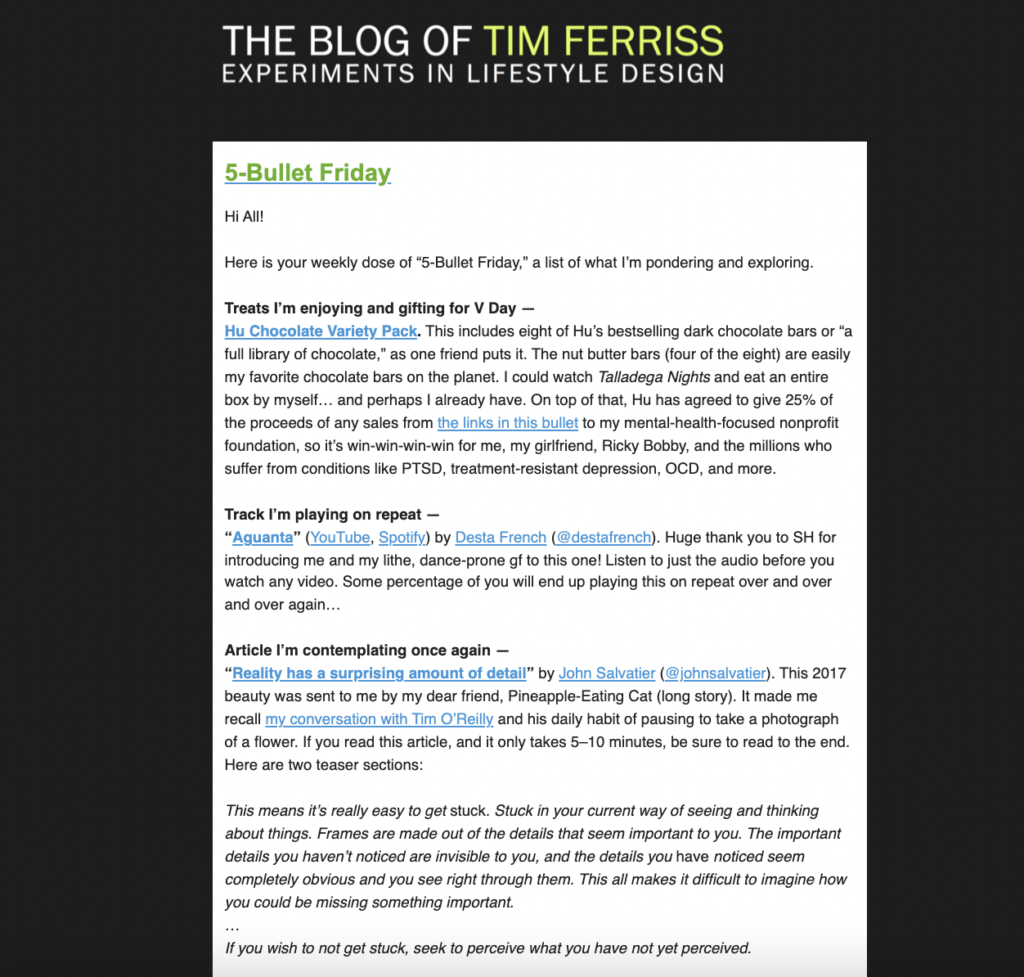
Tim Ferriss curates a list of 5 things he’s consuming for the week, typically an item he’s enjoying, a music track he’s listening to, an article he’s reading, a podcast he’s listening to, and a quote he’s pondering. He also includes a bonus post-script (PS) at the end of his emails with a deal of the week. His newsletter perfectly balances promoting affiliate products while providing value for his readership. Ferriss’s newsletter is full of affiliate links and yet isn’t immediately apparent because he weaves it in and out of original content.
Tim Ferriss has a large following in the self-help space, so placing so many affiliate links within your newsletter may not work as well for your industry. Instead, consider placing only one or two affiliate links to products per email so your audience doesn’t experience promotional overload.
Help Your Affiliates Promote Your Products Today
Start your affiliate program in minutes with GrowthHero, the all-in-one affiliate app, and grow your business to new heights.
Embed links in video descriptions
Sharing video content is a way to supplement your written content. Actually, you can repurpose your old blog articles by transforming them into videos.
So, how can you embed these links within your video descriptions? Add them to the video descriptions and also give a shoutout in your video.
Take a look at how our GrowthHero affiliates use this:

Skyler Cowans is a video creator who explores wellness spirituality and alternative lifestyles. She primarily uses Youtube to share her content and has profiles across other social channels like Instagram. Cowans works with our GrowthHero affiliate program, Komusō. You can find Komusō in our affiliate marketplace.
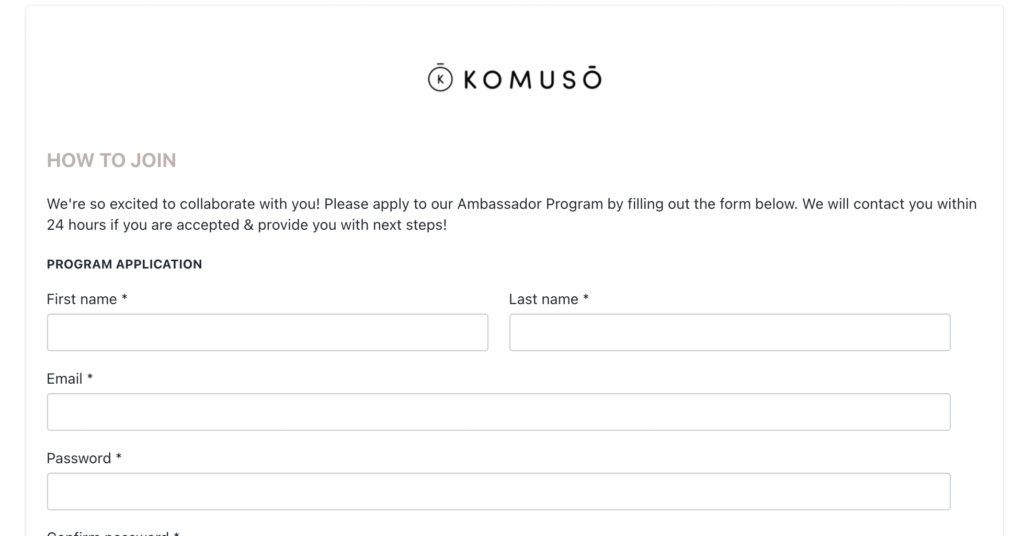
Komuso makes breathing necklaces especially marketed towards individuals with anxiety problems (realistically, who doesn’t deal with anxiety from time to time?). The necklace helps you breathe deeply through your diaphragm to promote slower, measured breathing. Skyler Cowan is one of their affiliates, promoting their products on her Youtube channel, offering her affiliate discount upon purchase.
As you can see, adding an affiliate link in your video is as simple as pasting the link in the video description.
Use affiliate links in your product reviews and tutorials
As a content marketer and affiliate, it’s essential to have both reviews and tutorials for your audience. For affiliate marketing, reviews (or product comparisons) help you make the most money. They target your readers with the intent to buy. Tutorials are also efficient moneymakers because they walk your audience through the product, showing them how to use it and what to expect when using it.
To effectively market affiliate products, you should use both to grow your own affiliate blog. But, not all of your content should be for-profit affiliate products. Instead, it’s best to mix not-for-profit affiliate products with for-profit ones so that your audience trusts you to give them honest reviews.
To create the best product reviews and tutorials, you’ll need to know the products inside and out. Then, you’ll want to optimize your social media posts using SEO best practices. In your reviews, give your readers all of the information they need about the product to make an informed purchasing decision. Show them how to use it in a video, or use screenshots in your content. Give an honest review, not shying away from any of the product’s weaknesses. This honesty creates trust with your readers.
Throughout your blog posts, insert a call to action (CTA) or two. In a video, mention discounts your audience will receive should they want to purchase the product or try out the service.
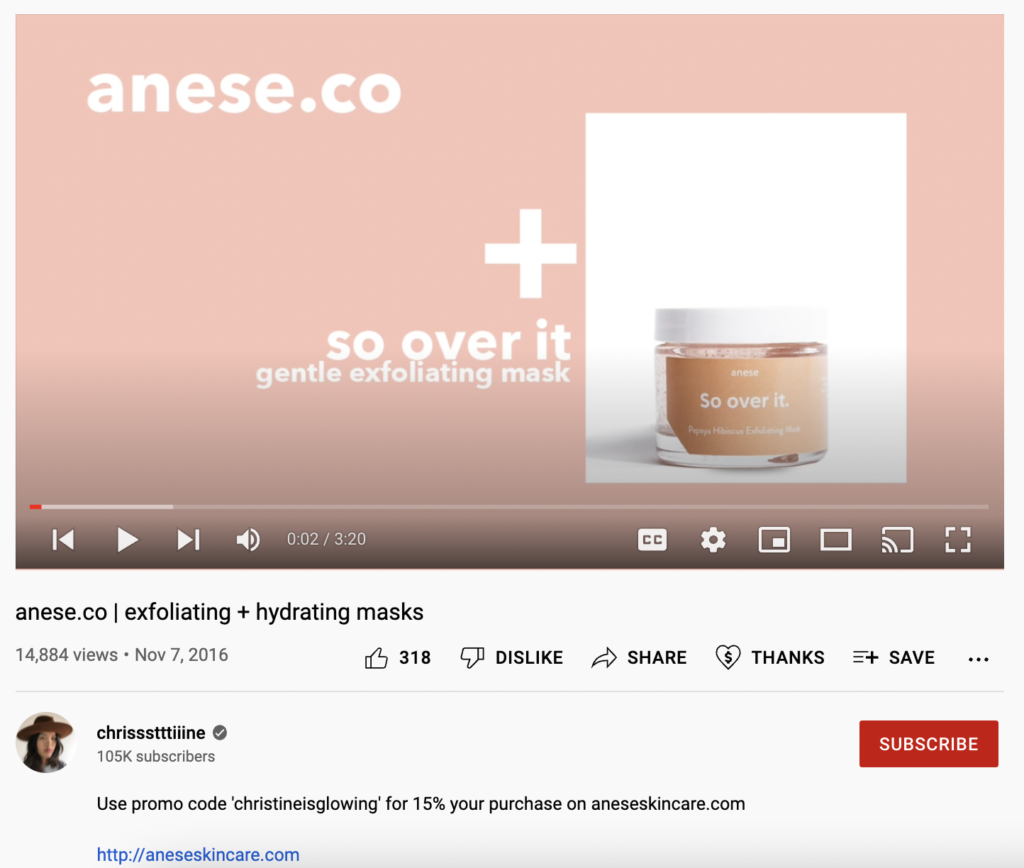
Take a look at how our GrowthHero affiliates use this:
Anese.co is a skincare brand and another GrowthHero affiliate program found in our Marketplace. In the above example, Youtube user chrissstttiiine reviews their product on her channel and also provides a tutorial on how to use the product. If you look in the video description, you’ll see her affiliate discount. This is a perfect example of how to combine product tutorials with your affiliate links.
Insert links in your blog posts
Another way to promote affiliate links is by inserting links in your blog posts. Affiliates use blog posts in different ways to promote their affiliate links.
Here’s how to add affiliate links to your blog
You can use a traditional “best-of” list where you review many different products, including the products you market or you can focus on a single affiliate product.
When writing your content, ensure you’re using the best keywords relevant to your product and industry. This way, customers will find you organically through Google searches. Not sure how to research keywords for your content? View PluginUseful’s guide on finding keywords that drive more traffic.
Promote links on social media and forums
This is a standard method for promoting your affiliate links. With social media, you can place your affiliate links directly in your posts. Many affiliates add reels of their favorite products with discount codes in the comments or post a review directly on their account with a photo of themselves with the product.
Other than social media, many affiliates use forums to promote their products by answering questions related to the product. This does two things: 1) provides value for the OP (original poster), and 2) educates the reader on how the product can help them. Now, on forums like Quora or Reddit, you cannot post affiliate links in your posts, or else it’ll be labeled as spam, but you can direct organic traffic to the affiliate landing page.
Take a look at how our GrowthHero affiliates use this:
SimCorner is another GrowthHero affiliate program found in our Marketplace. One of their affiliates posted on Quora about the benefits of using a SIM card for use in the United States and unlimited calling:
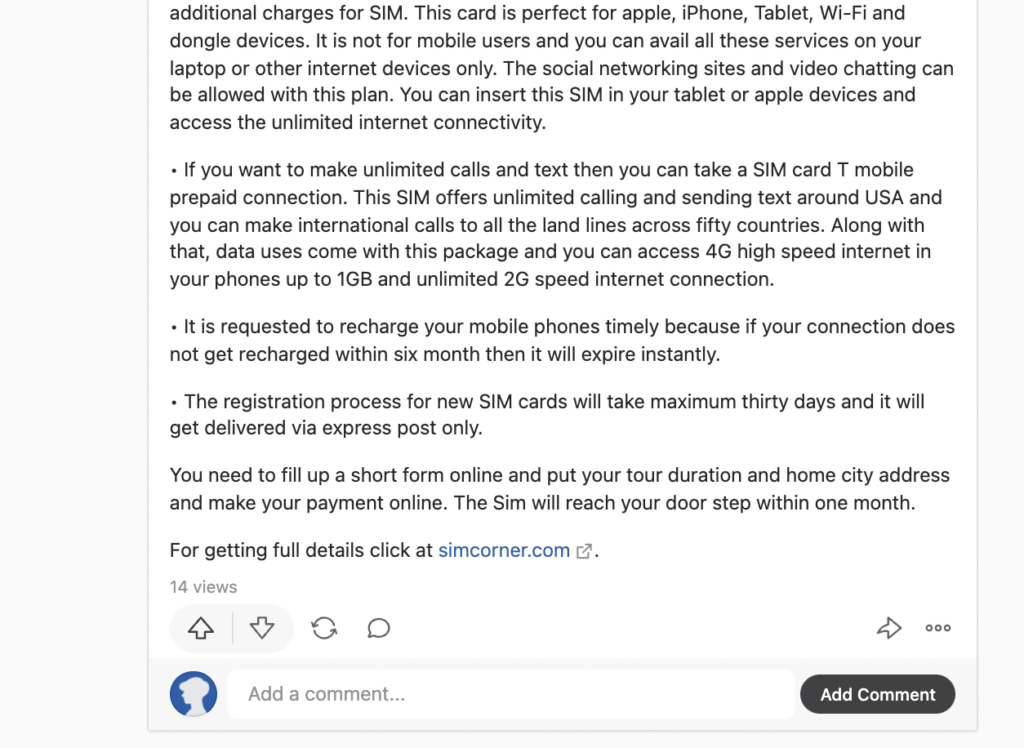
This is a more discreet way to market the product because there isn’t an obvious affiliate link found in the post. Instead, the affiliate reviews the benefits of a SIM card and directs the user to check out simcorner.com’s offerings.
And there you have it, your guide to promoting affiliate links. To summarize, if you’re an affiliate marketer looking for ways to promote your links, there are plenty of strategies that may work well. The key is experimentation – so be sure to try out different marketing avenues and see what works best for you! Be on the lookout for future posts in our GrowthHero.io blog, where we’ll discuss more tips like these!